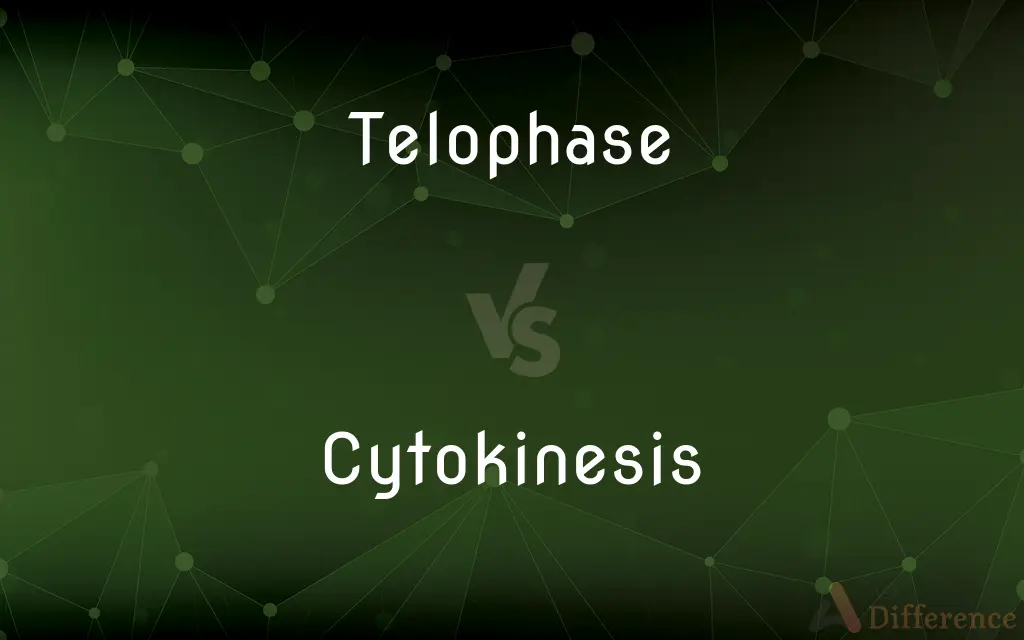Telophase vs. Cytokinesis — What's the Difference?
By Fiza Rafique & Urooj Arif — Updated on April 15, 2024
Telophase is the final stage of mitosis where chromosomes decondense and nuclear envelopes reform, while cytokinesis is the process of cell division to form two separate cells.

Difference Between Telophase and Cytokinesis
Table of Contents
ADVERTISEMENT
Key Differences
Telophase marks the end of nuclear division in mitosis, characterized by the reformation of the nuclear envelope around each set of separated sister chromatids, now distinct nuclei. On the other hand, cytokinesis follows telophase and involves the physical splitting of the cell's cytoplasm into two daughter cells, each containing one of the newly formed nuclei.
In telophase, the chromosomes that were previously condensed and separated at the metaphase plate begin to decondense, becoming less visible under a microscope. Whereas in cytokinesis, the focus is on the division of the cytoplasm, which includes the distribution of cell organelles and cytosol between the two forming daughter cells.
The process of telophase involves the reorganization of the nuclear structure, including the nucleolus becoming visible again within each daughter nucleus. On the other hand, cytokinesis is marked by the formation of a cleavage furrow in animal cells or a cell plate in plant cells, which physically separates the cell into two parts.
Telophase is primarily concerned with setting the stage for the genetic material to return to its interphase state, ensuring each daughter nucleus has the correct number of chromosomes. In contrast, cytokinesis ensures that all other cellular contents are evenly divided and contained within the new cells' boundaries.
The completion of telophase leads directly into cytokinesis, showing a direct linkage in the cell cycle; however, these processes focus on different aspects of cell division—telophase on the nucleus and cytokinesis on the cytoplasm.
ADVERTISEMENT
Comparison Chart
Focus of Process
Nuclear division completion
Division of cytoplasm
Key Events
Nuclear envelope reformation, chromosome decondensation
Cleavage furrow formation, cytoplasm division
Microscopic Visibility
Chromosomes become less visible
Visible cleavage or cell plate formation
Role in Cell Cycle
Finalizes nuclear division
Completes physical separation of daughter cells
Outcome
Two nuclei in one cell
Two physically separate daughter cells
Compare with Definitions
Telophase
The final stage of mitosis or meiosis, where chromosomes reach the cell's opposite poles.
During telophase, each pole forms a new nucleus.
Cytokinesis
The process during cell division in which the cell cytoplasm divides, creating two daughter cells.
Cytokinesis follows telophase in the cell cycle.
Telophase
The process concluding nuclear division before cytokinesis begins.
Telophase sets the stage for cytokinesis by reorganizing nuclear material.
Cytokinesis
A cell division phase distinct from and following the nuclear division.
After nuclear division in telophase, cytokinesis completes cell division.
Telophase
A phase characterized by the decondensation of chromosomes and reassembly of the nuclear envelope.
Telophase restores the nuclei before the cell divides.
Cytokinesis
Essential for physically separating the daughter cells after mitosis.
Without cytokinesis, daughter nuclei would remain in one cell.
Telophase
A critical transition from mitotic chromosome separation to the establishment of daughter nuclei.
In telophase, chromosomes begin to assume their interphase form.
Cytokinesis
The division of cell organelles and other contents between two new cells.
Cytokinesis ensures each daughter cell has necessary organelles and enzymes.
Telophase
The stage where nucleoli reappear and the spindle fibers disappear.
The reformation of nucleoli during telophase indicates the end of active chromosome movement.
Cytokinesis
Involves the formation of a cleavage furrow in animal cells or a cell plate in plant cells.
Cytokinesis in plant cells involves building a new cell wall.
Telophase
Telophase (from the Greek τέλος (télos), "end" and φάσις (phásis), "stage") is the final stage in both meiosis and mitosis in a eukaryotic cell. During telophase, the effects of prophase and prometaphase (the nucleolus and nuclear membrane disintegrating) are reversed.
Cytokinesis
Cytokinesis () is the part of the cell division process during which the cytoplasm of a single eukaryotic cell divides into two daughter cells. Cytoplasmic division begins during or after the late stages of nuclear division in mitosis and meiosis.
Telophase
The final stage of mitosis or meiosis during which the chromosomes of daughter cells are grouped in new nuclei.
Cytokinesis
The division of the cytoplasm of a cell following the division of the nucleus.
Telophase
(biology) The final stage of mitosis or meiosis during which the daughter chromosomes move towards opposite ends of the nuclear spindle
Cytokinesis
(biology) The process in which the cytoplasm of a cell divides following the division of the nucleus.
Telophase
The final stage of meiosis when the chromosomes move toward opposite ends of the nuclear spindle
Cytokinesis
Organic process consisting of the division of the cytoplasm of a cell following karyokinesis bringing about the separation into two daughter cells
Telophase
The final stage of mitosis
Common Curiosities
What primarily differentiates telophase from cytokinesis?
Telophase focuses on nuclear reformation, while cytokinesis involves the division of the cytoplasm.
What happens if cytokinesis does not occur after telophase?
If cytokinesis fails, the result is a multinucleated cell, which can lead to cellular dysfunction.
Why is telophase important in cell division?
Telophase ensures that each daughter cell receives a complete set of chromosomes within a newly formed nucleus.
Can cytokinesis occur without telophase?
Cytokinesis typically follows telophase and is rarely seen without the prior completion of nuclear division.
Is telophase identical in mitosis and meiosis?
Telophase occurs in both, but it differs slightly due to the type of genetic separation and the number of cell divisions involved.
What experimental methods are used to study cytokinesis?
Live cell imaging and genetic manipulation are common methods used to study cytokinesis dynamics.
How does cytokinesis differ in plant and animal cells?
Animal cells form a cleavage furrow that pinches the cell in two, whereas plant cells build a cell plate that becomes a new cell wall.
How is cytokinesis regulated?
It is tightly controlled by various proteins and signaling pathways to ensure proper division and distribution of cell components.
What molecular processes drive cytokinesis?
Actin and myosin filaments play a crucial role in forming the contractile ring during animal cell cytokinesis.
What tools are used to study telophase and cytokinesis?
Microscopy, especially fluorescence microscopy, is used to visualize the stages of telophase and cytokinesis.
What structural changes occur during telophase?
Chromosomes decondense, and the nuclear envelope re-forms around each set of chromosomes.
How long does cytokinesis take compared to telophase?
Cytokinesis generally takes about an hour, similar to telophase, but timing can vary based on cell type and conditions.
Can cytokinesis be medically significant?
Errors in cytokinesis can lead to diseases such as cancer, where abnormal cell division occurs.
Share Your Discovery

Previous Comparison
Preschool vs. Playschool
Next Comparison
Strength vs. WeaknessAuthor Spotlight
Written by
Fiza RafiqueFiza Rafique is a skilled content writer at AskDifference.com, where she meticulously refines and enhances written pieces. Drawing from her vast editorial expertise, Fiza ensures clarity, accuracy, and precision in every article. Passionate about language, she continually seeks to elevate the quality of content for readers worldwide.
Co-written by
Urooj ArifUrooj is a skilled content writer at Ask Difference, known for her exceptional ability to simplify complex topics into engaging and informative content. With a passion for research and a flair for clear, concise writing, she consistently delivers articles that resonate with our diverse audience.














































